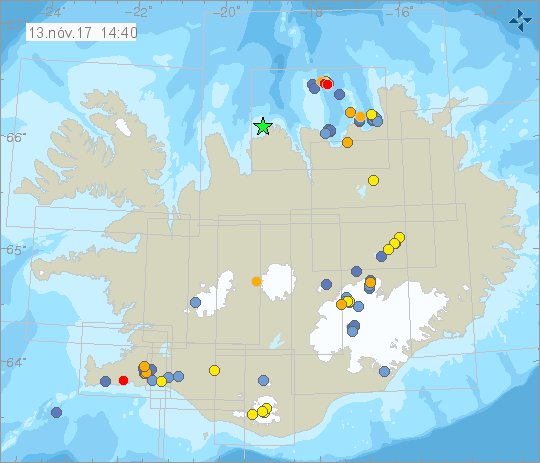A sharp earthquake off the north coast of Iceland was felt in the towns on Tröllaskagi peninsula, from Hofsós to Siglufjörður and Ólafsfjörður. The seismic monitoring system of the Icelandic Meteorological office shows that the quake, a 3.7 magnitude tremor, hit early morning at 7:36 am. Its epicenter was 11.2 km (7 mi) northwest of the town of Siglufjörður, at a depth of 12.5 km (7.8 mi).

Read more: Why the constant earthquakes? Iceland is slowly being torn apart
An area known for high seismic activity
The quake took place in Tjörnesbrotabelti, a region known for regular seismic activity, at the western edge of the Tjörnes rift zone. The area is part of the North Atlantic Ridge and is known for high geothermal activity and regular and significant seismic activity, caused by energy being released as the tectonic plates drift in opposite directions from one another.
Read more: Sharp earthquake swarm by Grímsey island, Iceland's northernmost settlement
The rift zone has been very active in the past few weeks. Several sharp quakes and a number of large earthquake swarms were detected further east on the rift zone, around the small island of Grímsey. A large swarm of more than 120 quakes, including four 3+ magnitude tremors, hit the island on Friday October 6, followed by a second swarm on October 18.

A sharp earthquake off the north coast of Iceland was felt in the towns on Tröllaskagi peninsula, from Hofsós to Siglufjörður and Ólafsfjörður. The seismic monitoring system of the Icelandic Meteorological office shows that the quake, a 3.7 magnitude tremor, hit early morning at 7:36 am. Its epicenter was 11.2 km (7 mi) northwest of the town of Siglufjörður, at a depth of 12.5 km (7.8 mi).

Read more: Why the constant earthquakes? Iceland is slowly being torn apart
An area known for high seismic activity
The quake took place in Tjörnesbrotabelti, a region known for regular seismic activity, at the western edge of the Tjörnes rift zone. The area is part of the North Atlantic Ridge and is known for high geothermal activity and regular and significant seismic activity, caused by energy being released as the tectonic plates drift in opposite directions from one another.
Read more: Sharp earthquake swarm by Grímsey island, Iceland's northernmost settlement
The rift zone has been very active in the past few weeks. Several sharp quakes and a number of large earthquake swarms were detected further east on the rift zone, around the small island of Grímsey. A large swarm of more than 120 quakes, including four 3+ magnitude tremors, hit the island on Friday October 6, followed by a second swarm on October 18.







